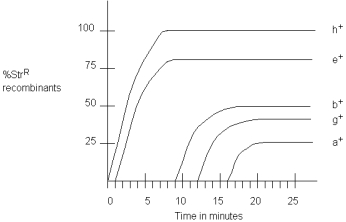At time zero,an Hfr strain (strain 1)was mixed with an F- strain,and at various times after mixing,samples were removed and agitated to separate conjugating cells.The cross may be written as:
HFr 1:
No order is implied in the above listing.The samples were then plated onto selective media to measure the frequency of h+StrR recombinants that had received certain genes from the Hfr cell.The following graph shows the percentage of recombinants against time in minutes. 
a)Draw a linear map of the Hfr chromosome indicating:
(1)the point of insertion (origin).
(2)the order of the genes a+,b+,e+,g+,and h+.
(3)the shortest distance between consecutive genes on the chromosome in minutes.
b)An additional four Hfr strains (strains 2 5)were obtained.Each carried the wild-type alleles of the genes listed below.They were mated individually to the same F- strain shown above (carrying the recessive alleles of all genes).With interrupted mating,the times of first appearance in minutes of individual Hfr markers in exconjugants were determined,as shown in the following chart.
Draw the genetic map showing:
(1)the positions of genes a through h.
(2)the origins of the Hfrs (including strain 1).
(3)the orientation of the origins.
(4)the shortest distance between consecutive genes or origins.
Definitions:
Ileostomy
A surgical opening from the ileum onto the abdominal wall.
Ileum
The last section of the small intestine.
Chyme
The semi-fluid mass of partly digested food that is passed from the stomach to the small intestine for further digestion.
Small Intestine
The part of the digestive tract that absorbs nutrients and minerals from food, extending from the stomach to the large intestine.
Q4: A trihybrid plant (A/a;B/b;C/c)is selfed.Assuming no effects
Q13: Transgenic plants can be generated using T-DNA
Q14: Which of the following is evidence that
Q15: Adenine and thymine are held together by
Q16: The replisome contains a protein subunit responsible
Q36: post-translational control of biosynthetic pathway<br>A)temporal control<br>B)positive control<br>C)negative
Q40: In wheat,a cross between red-kernel and white-kernel
Q43: A male Drosophila melanogaster has the genotype
Q46: In the presence of the sugar galactose,the
Q118: Improving service-sector productivity is the next major